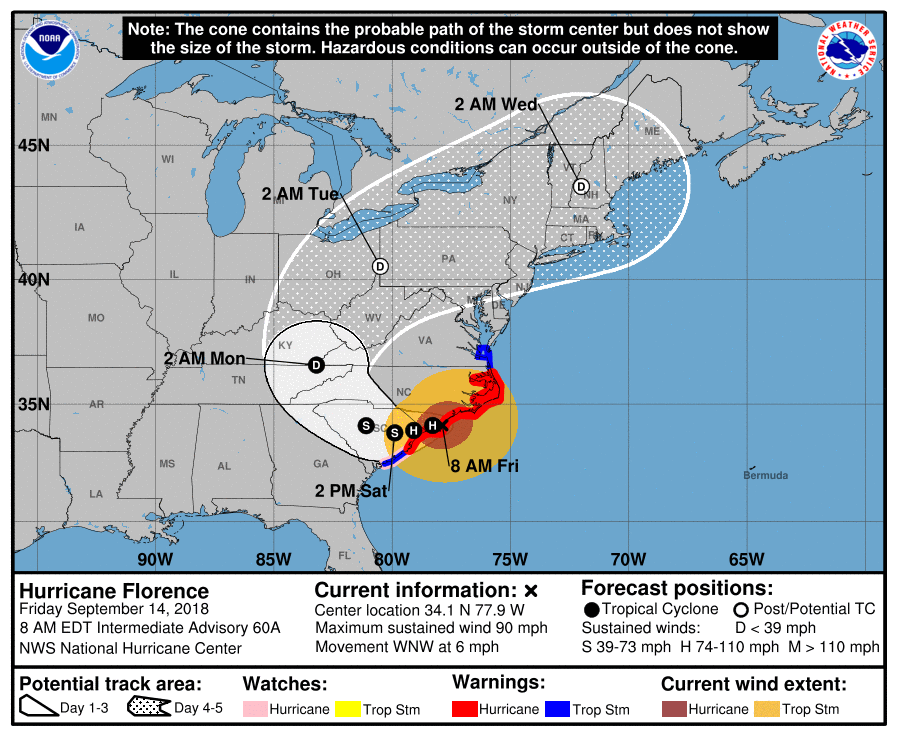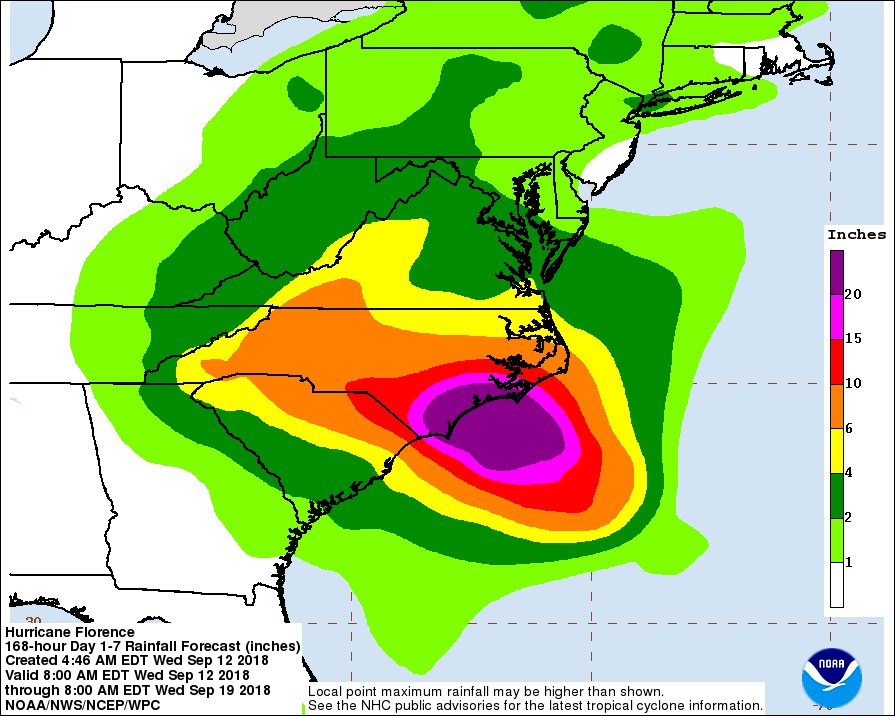Hurricane Florence made landfall at 7:15 am Friday near Wrightsville Beach, North Carolina. Though the storm had been downgraded to a Category 1 late Thursday, the National Hurricane Center continues to warn residents in its path of life-threatening storm surge, heavy rainfall, and catastrophic freshwater flooding.
Observers continue to reported maximum sustained winds of around 90 mph as of 8 a.m. Friday, with hurricane-force winds extending up to 80 miles from the storm’s center and tropical storm-force winds up to 195 miles from the center.
More than 10 million people are under hurricane watches or warnings and 1.7 million have been ordered to evacuate the coast.
Despite the slight downgrade in windspeed, Hurricane Florence is still expected to batter the Carolina coast with storm surge of up to 13 feet and dump up to 40 inches of rain as its path travels inland and down the coast.
Here’s what you need to know about Hurricane Florence, including its current path and the latest forecast:
Where is Hurricane Florence’s path headed?

As of 8 a.m. Friday, the eye of the storm was located about 10 miles south of Wilmington, North Carolina, moving inland at 6 mph. The center of the storm is expected to move farther inland across southeastern North Carolina and eastern South Carolina through Friday and Saturday.
From Thursday night through the rest of the weekend, an area from Northern Florida to Southern New Jersey — and as far inland as Kentucky and Tennessee — could experience tropical storm-force winds.
Hurricane and storm surge warnings extend from the entire coast of North Carolina through central South Carolina. Both warnings are in effect from South Santee, South Carolina to Duck, North Carolina, and the Albermarle and Palmico Sounds.
More than 1.2 million people are under mandatory evacuation orders. On Monday, South Carolina Gov. Henry McMaster ordered evacuations for nearly the entire coastline ahead of the hurricane. The evacuation order affects nearly every county along the state’s coast, including Charleston, Beaufort, Berkeley and Dorchester counties.
“We’re in for a real episode here,” McMaster said, later adding: “The atmospheric conditions are such that nothing’s stopping it.”
Mandatory evacuation orders were issued to parts of southeastern North Carolina, where Florence is expected to make the biggest impact. Additionally, all residents of Pamlico County, Dare County and Tyrrell County around the Outer Banks and Pamlico Sound were ordered to evacuate. Officials at the University of North Carolina Wilmington issued a mandatory evacuation of all students.
On Monday, Virginia Governor Ralph Northam announced that Florence was a “serious storm” set to affect all of Virginia and ordered mandatory evacuations for 245,000 residents living in the state’s low lying coastal areas. Residents in Hampton Roads and Eastern Shore were advised to seek higher ground and move inland to avoid danger. The order went into effect Tuesday morning as Hurricane Florence gains wind speeds and prepares to make landfall later this week. As of Tuesday afternoon officials announced the University of Mary Washington in Fredericksburg will be shutting down campuses until Monday.

Hurricane Florence’s path likely brings “extreme danger”
“It’s very similar to Hurricane Harvey because Harvey was a slow-tracking hurricane which weakened to a tropical storm, and this could be the same kind of situation,” said AccuWeather hurricane expert Dan Kottlowski. “The meteorological set up of Hurricane Florence is different than Hurricane Harvey’s, but it will still produce heavy rainfall.”
Rainfall will be a major concern during Hurricane Florence, with an average of 8-16 inches over large areas of North Carolina into Virginia, he said. Depending on how slow the storm moves once it’s inland, it has the potential to produce 2 -3 feet of flooding in parts of eastern North Carolina and possibly Virginia. Areas like Myrtle Beach, S.C., Wilmington, N.C. and Jacksonville, N.C. could be hit the hardest overall, Kottlowski said. Isolated parts of South Carolina could see up to 40 inches of rainfall, according to the National Hurricane Center, while parts of North Carolina could be hit with 20 to 30 inches.

Given Hurricane Florence’s expected track and path, South Carolina, North Carolina, Virginia and Washington D.C. declared states of emergency earlier in the week as authorities prepared to deal with Hurricane Florence. Georgia followed suit on Wednesday.
Storm surges of anywhere from 10-15 feet are anticipated, Kottlowski said. They are expected along the coastlines of South Carolina, North Carolina and Virginia, as is a risk of freshwater flooding “from a prolonged and exceptionally heavy rainfall event inland and damaging hurricane force winds,” the National Hurricane Center said.
Forecasters also warned that large swells, which will cause “life threatening surf and rip currents,” are already hitting Bermuda and parts of the East Coast.
McMaster said Sunday he was asking President Donald Trump for a federal emergency declaration in anticipation of “significant impacts not only on our state but the entire East Coast.”
“Pretend, assume, presume that a major hurricane is going to hit right smack dab in the middle of South Carolina and is going to go way inshore,” McMaster said at a press conference.
More Must-Reads from TIME
- Why Trump’s Message Worked on Latino Men
- What Trump’s Win Could Mean for Housing
- The 100 Must-Read Books of 2024
- Sleep Doctors Share the 1 Tip That’s Changed Their Lives
- Column: Let’s Bring Back Romance
- What It’s Like to Have Long COVID As a Kid
- FX’s Say Nothing Is the Must-Watch Political Thriller of 2024
- Merle Bombardieri Is Helping People Make the Baby Decision
Write to Gina Martinez at gina.martinez@time.com and Alejandro de la Garza at alejandro.delagarza@time.com